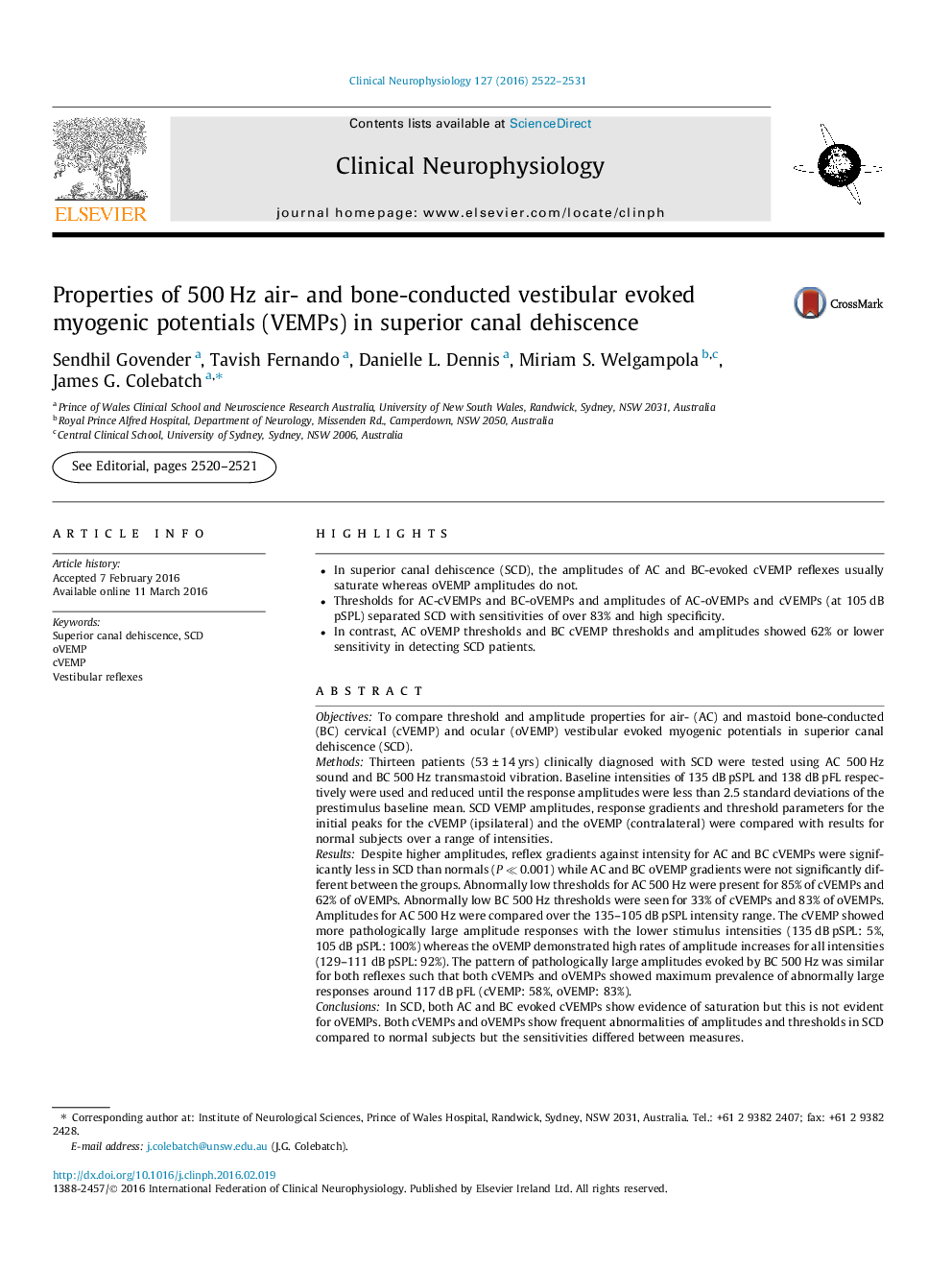| Article ID | Journal | Published Year | Pages | File Type |
|---|---|---|---|---|
| 3042756 | Clinical Neurophysiology | 2016 | 10 Pages |
•In superior canal dehiscence (SCD), the amplitudes of AC and BC-evoked cVEMP reflexes usually saturate whereas oVEMP amplitudes do not.•Thresholds for AC-cVEMPs and BC-oVEMPs and amplitudes of AC-oVEMPs and cVEMPs (at 105 dB pSPL) separated SCD with sensitivities of over 83% and high specificity.•In contrast, AC oVEMP thresholds and BC cVEMP thresholds and amplitudes showed 62% or lower sensitivity in detecting SCD patients.
ObjectivesTo compare threshold and amplitude properties for air- (AC) and mastoid bone-conducted (BC) cervical (cVEMP) and ocular (oVEMP) vestibular evoked myogenic potentials in superior canal dehiscence (SCD).MethodsThirteen patients (53 ± 14 yrs) clinically diagnosed with SCD were tested using AC 500 Hz sound and BC 500 Hz transmastoid vibration. Baseline intensities of 135 dB pSPL and 138 dB pFL respectively were used and reduced until the response amplitudes were less than 2.5 standard deviations of the prestimulus baseline mean. SCD VEMP amplitudes, response gradients and threshold parameters for the initial peaks for the cVEMP (ipsilateral) and the oVEMP (contralateral) were compared with results for normal subjects over a range of intensities.ResultsDespite higher amplitudes, reflex gradients against intensity for AC and BC cVEMPs were significantly less in SCD than normals (P ≪ 0.001) while AC and BC oVEMP gradients were not significantly different between the groups. Abnormally low thresholds for AC 500 Hz were present for 85% of cVEMPs and 62% of oVEMPs. Abnormally low BC 500 Hz thresholds were seen for 33% of cVEMPs and 83% of oVEMPs. Amplitudes for AC 500 Hz were compared over the 135–105 dB pSPL intensity range. The cVEMP showed more pathologically large amplitude responses with the lower stimulus intensities (135 dB pSPL: 5%, 105 dB pSPL: 100%) whereas the oVEMP demonstrated high rates of amplitude increases for all intensities (129–111 dB pSPL: 92%). The pattern of pathologically large amplitudes evoked by BC 500 Hz was similar for both reflexes such that both cVEMPs and oVEMPs showed maximum prevalence of abnormally large responses around 117 dB pFL (cVEMP: 58%, oVEMP: 83%).ConclusionsIn SCD, both AC and BC evoked cVEMPs show evidence of saturation but this is not evident for oVEMPs. Both cVEMPs and oVEMPs show frequent abnormalities of amplitudes and thresholds in SCD compared to normal subjects but the sensitivities differed between measures.SignificancePrevious evidence of saturation of cVEMP responses in SCD was confirmed. For diagnosis, AC cVEMP amplitudes at 105 dB pSPL or AC-evoked oVEMP amplitudes both have over 90% sensitivity in separating SCD from normal responses.
